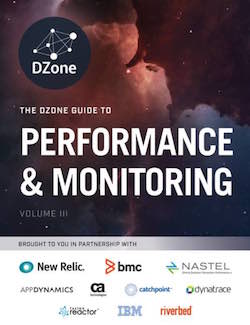Performance and Monitoring Guide from DZone
My contribution to DZone Performance and Monitoring Guide
I am delighted to announce that I am a featured author in DZone Performance and Monitoring Guide that released recently.
Download Now!
This guide contains everything from finding the root cause of a performance issue to designing parallel algorithms.
Find out what 600 developers (including myself) have to say about monitoring, database performance, application logs, multi-threading, and more. Discover some important latency numbers so you can troubleshoot performance problems and prevent future bottlenecks. Explore an extensive solutions directory that allows you to compare the industry’s top performance tools.
This 53 page book contains all you need to monitor and improve performance of your application.
- Original research regarding developer trends in performance and monitoring usage.
- 8 articles written by industry experts.
- An awesome info-graphic called “Bottlenecks + Latencies: How to keep your threads busy”.
- A checklist for Latency Numbers Everyone Should Know.
- A comparative list of 80+ premier performance and monitoring solutions providers.
Tony Hoare notoriously observed, “Premature optimization is the root of all evil”. That is, the benefits of absolutely maximal optimization are usually much lower than the increased cost of maintenance and debugging that results from the brittleness caused by that optimization.
On the other hand, the natural tendency of OOP to prioritize form over performance can generate a codebase that is highly readable but partitioned such that performance-oriented refactoring may prove extremely difficult.
To help you steer between overeager optimization and the runtime-indifferent code structure, this publication has been split in ways to design performant systems and ways to monitor performance in the real world.
As per the survey of nearly 600 developers, the 4 major areas of concern in application performance and the ways to approach those problems have been dealt with extensively in the guide:
- Application code is most likely to cause performance problems frequently; database performance problems are most challenging to fix.
- Parallelization is regularly built into program design by only a minority of enterprise developers.
- Performance is still a second-stage design consideration, but not by much.
- Manual firefighting, lack of actionable insights, and heterogeneous IT environments are the top three monitoring challenges.
Topics covered in this book include:
- Key Research Findings.
- Effective APM: Find and Fix the Things That Matter.
- Know When (and When Not) to Blame Your Network.
- Performance Patterns in Microservices-Based Integrations.
- Working in Parallel: On the Complications of Parallel Algorithm Design.
- Bottlenecks and Latencies: How to Keep Your Threads Busy.
- Latency Numbers Everyone Should Know.
- How HTTP/2 Is Changing Web Performance Best Practices.
- Benchmarking Java Logging Frameworks.
- Executive Insights on Performance and Monitoring.
- Why You Need to Know Your Pages’ Conversion Impact Score.
- Performance and Monitoring Solutions Directory.
- Diving Deeper into Performance and Monitoring.
Download the book now and let me know what you think! Spread the word! Tweet and share the guide.
